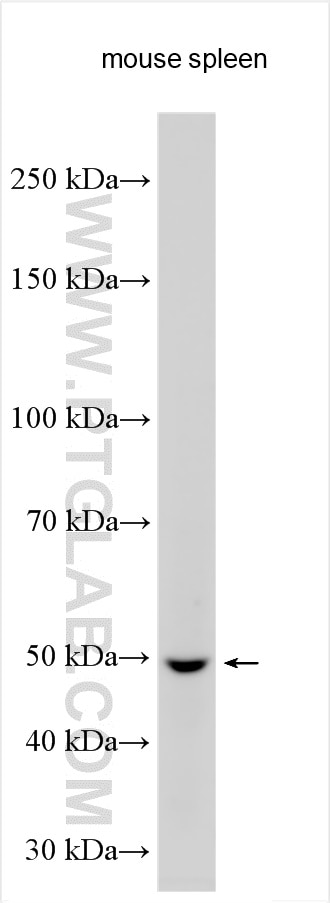Tested Applications
| Positive WB detected in | mouse spleen tissue |
Recommended dilution
| Application | Dilution |
|---|---|
| Western Blot (WB) | WB : 1:500-1:2000 |
| It is recommended that this reagent should be titrated in each testing system to obtain optimal results. | |
| Sample-dependent, Check data in validation data gallery. | |
Product Information
30905-1-AP targets PNPLA1 in WB, ELISA applications and shows reactivity with human, mouse samples.
| Tested Reactivity | human, mouse |
| Host / Isotype | Rabbit / IgG |
| Class | Polyclonal |
| Type | Antibody |
| Immunogen |
CatNo: Ag34139 Product name: Recombinant human PNPLA1 protein Source: e coli.-derived, PGEX-4T Tag: GST Domain: 1-59 aa of BC103907 Sequence: MVQMMRQFLYRVLPEDSYKVTTGKLHVSLTRLTDGENVVVSEFTSKEELIEALYCSCFV Predict reactive species |
| Full Name | patatin-like phospholipase domain containing 1 |
| Calculated Molecular Weight | 532 aa, 58 kDa |
| Observed Molecular Weight | 48kDa;58kDa |
| GenBank Accession Number | BC103907 |
| Gene Symbol | PNPLA1 |
| Gene ID (NCBI) | 285848 |
| RRID | AB_3669778 |
| Conjugate | Unconjugated |
| Form | Liquid |
| Purification Method | Antigen affinity Purification |
| UNIPROT ID | Q8N8W4 |
| Storage Buffer | PBS with 0.02% sodium azide and 50% glycerol, pH 7.3. |
| Storage Conditions | Store at -20°C. Stable for one year after shipment. Aliquoting is unnecessary for -20oC storage. 20ul sizes contain 0.1% BSA. |
Background Information
PNPLA1 is a member of the patatin-like phospholipase (PNPLA) family. PNPLAs are highly conserved enzymes of prokaryotic and eukaryotic organisms that play an important role in lipid homeostasis. PNPLA1 has been identified as an essential transacylase for acylceramide biosynthesis to maintain the epidermal permeability barrier (PMID: 30290227). It is mainly expressed in the skin and has 3 isoforms with MW of 58, 48 and 49 kDa.
Protocols
| Product Specific Protocols | |
|---|---|
| WB protocol for PNPLA1 antibody 30905-1-AP | Download protocol |
| Standard Protocols | |
|---|---|
| Click here to view our Standard Protocols |




